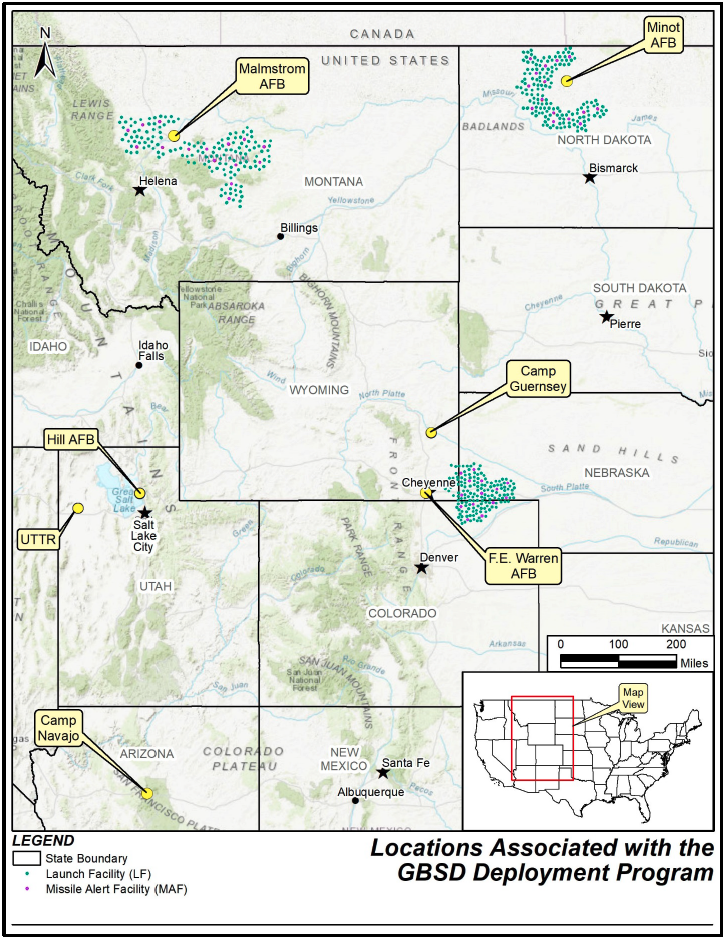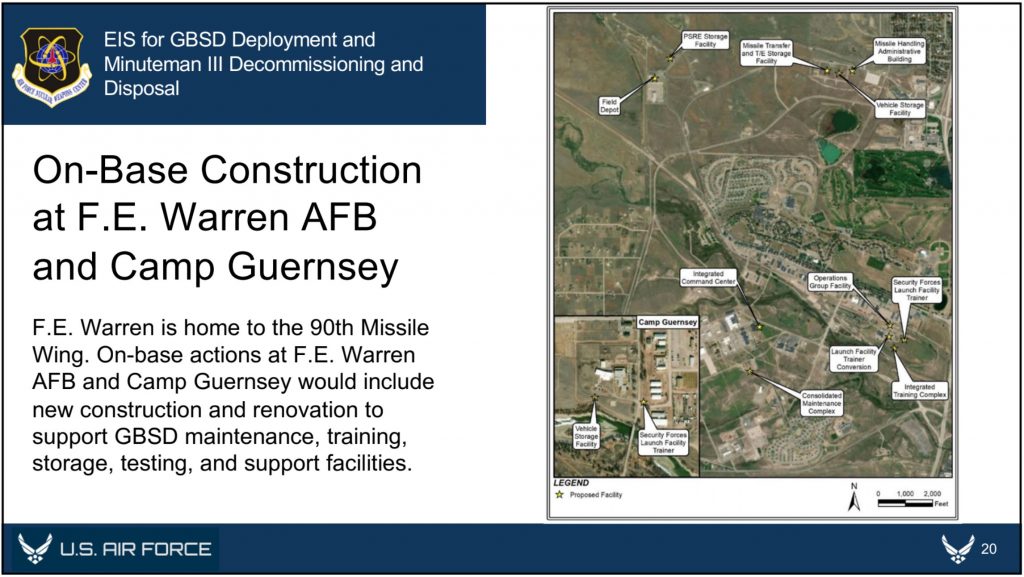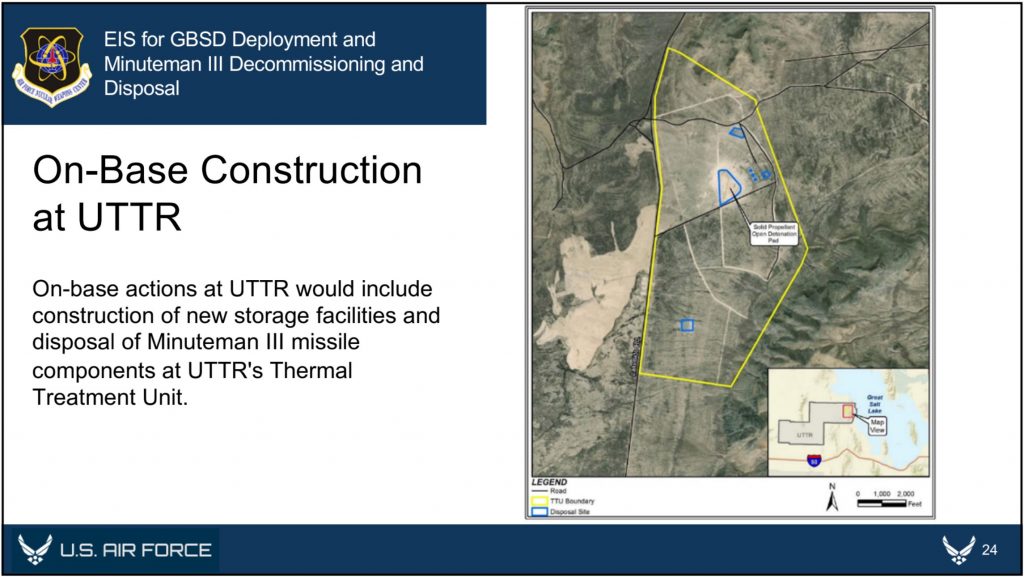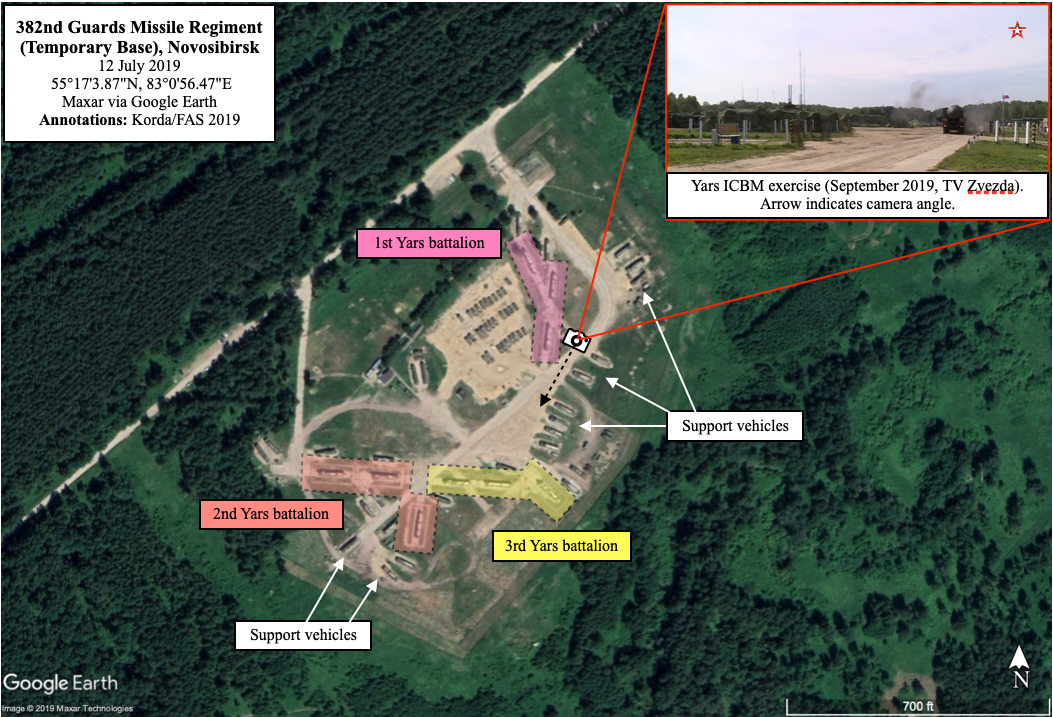New Environmental Assessment Reveals Fascinating Alternatives to Land-Based ICBMs
A new Air Force environmental assessment reveals that it considered basing ICBMs in underground railway tunnels––or possibly underwater.

Map of the ICBM missile fields contained within the Air Force’s July 2022 assessment.
On July 1st, the Air Force published its Draft Environmental Impact Statement (EIS) for its proposed ICBM replacement program, previously known as the Ground-Based Strategic Deterrent (GBSD) and now by its new name, “Sentinel.” The government typically conducts an EIS whenever a federal program could potentially disrupt local water supplies, transportation, socioeconomics, geology, air quality, and other related factors.
A comprehensive environmental assessment is certainly warranted in this case, given the tremendous scale of the Sentinel program––which consists of a like-for-like replacement of all 400 Minuteman III missiles that are currently deployed across Colorado, Montana, Nebraska, North Dakota, and Wyoming, plus upgrades to the launch facilities, launch control centers, and other supporting infrastructure.

Cover page of the Air Force’s July 2022 Draft Environmental Impact Statement for the GBSD.
The Draft EIS was anxiously awaited by local stakeholders, chambers of commerce, contractors, residents, and… me! Not because I’m losing sleep about whether Sentinel construction will disturb Wyoming’s Western Bumble Bee (although maybe I should be!), but rather because an EIS is also a wonderful repository for juicy, and often new, details about federal programs––and the Sentinel’s Draft EIS is certainly no exception.
Interestingly, the most exciting new details are not necessarily about what the Air Force is currently planning for the Sentinel, but rather about which ICBM replacement options they previously considered as alternatives to the current program of record. These alternatives were assessed during in the Air Force’s 2014 Analysis of Alternatives––a key document that weighs the risks and benefits of each proposed action––however, that document remains classified. Therefore, until they were recently referenced in the July 2022 Draft EIS, it was not clear to the public what the Air Force was actually assessing as alternatives to the current Sentinel program.
Missile alternatives
The Draft EIS notes that the Air Force assessed four potential missile alternatives to the current plan, which involves designing a completely new ICBM:
- Reproducing Minuteman III ICBMs to “existing specifications” by washing out and refilling the first- and second-stage rocket boosters; remanufacturing the third stages and Propulsion System Rocket Engine––the ICBM’s post-boost vehicle; and refurbishing and replacing all other subsystems;
The Air Force appears to have ultimately eliminated all four of these options from consideration because they did not meet all of their “selection standards,” which included criteria like sustainability, performance, safety, riskiness, and capacity for integration into existing or proposed infrastructure.
Of particular interest, however, is the Air Force’s note that the Minuteman III reproduction alternative was eliminated in part because it did not “meet the required performance criteria for ICBMs in the context of modern and evolving threats (e.g., range, payload, and effectiveness.” It is highly significant to state that the Minuteman III cannot meet the required performance criteria for ICBMs, given that the Minuteman III currently performs the ICBM role for the US Air Force and will continue to do so for the next decade.
This statement also suggests that “modern and evolving threats” are driving the need for an operationally improved ICBM; however, it is unclear what the Air Force is referring to, or how these threats would necessarily justify a brand-new ICBM with new capabilities. As I wrote in my March 2021 report, “Siloed Thinking: A Closer Look at the Ground-Based Strategic Deterrent,”
“With respect to US-centric nuclear deterrence, what has changed since the end of the Cold War? China is slowly but steadily expanding its nuclear arsenal and suite of delivery systems, and North Korea’s nuclear weapons program continues to mature. However, the range and deployment locations of the US ICBM force would force the missiles to fly over Russian territory in the event that they were aimed at Chinese or North Korean targets, thus significantly increasing the risk of using ICBMs to target either country. Moreover, […] other elements of the US nuclear force––especially SSBNs––could be used to accomplish the ICBM force’s mission under a revised nuclear force posture, potentially even faster and in a more flexible manner. […] It is additionally important to note that even if adversarial missile defenses improved significantly, the ability to evade missile defenses lies with the payload––not the missile itself. By the time that an adversary’s interceptor was able to engage a US ICBM in its midcourse phase of flight, the ICBM would have already shed its boosters, deployed its penetration aids, and would be guided solely by its reentry vehicle. Reentry vehicles and missile boosters can be independently upgraded as necessary, meaning that any concerns about adversarial missile defenses could be mitigated by deploying a more advanced payload on a life-extended Minuteman III ICBM.”
Of additional interest is the passage explaining why the Air Force dismissed the possibility of using the Trident II D5 SLBM as a land-based weapon:
“The D5 is a high-accuracy weapon system capable of engaging many targets simultaneously with overall functionality approaching that of land- based missiles. The D5 represents an existing technology, and substantial design and development cost savings would be realized; but the associated savings would not appreciably offset the infrastructure investment requirements (road and bridge enhancements) necessary to make it a land-based weapon system. In addition, motor performance and explosive safety concerns undermine the feasibility of using the D5 as a land-based weapon system.”
The Air Force’s concerns over road and bridge quality are probably justified––missiles are incredibly heavy, and America’s bridges are falling apart at a terrifying rate. However, it is unclear why the Air Force is not confident about the D5’s motor performance, given that even aging Trident SLBMs have performed very well in recent flight tests: in 2015 the Navy conducted a successful Trident flight test using “the oldest 1st stage solid rocket motor flown to date” (over 26 years old), with 2nd and 3rd stage motors that were 22 years old. In January 2021, Vice Admiral Johnny Wolfe Jr.––the Navy’s Director for Strategic Systems Programs––remarked that “solid rocket motors, the age of those we can extend quite a while, we understand that very well.” This is largely due to the Navy’s incorporation of nondestructive testing techniques––which involve sending a probe into the bore to measure the elasticity of the propellant––to evaluate the reliability of their missiles.
As a result, the Navy is not currently contemplating the purchase of a brand-new missile to replace its current arsenal of Trident SLBMs, and instead plans to conduct a second life-extension to keep them in service until 2084. However, the Air Force’s comments suggest either a lack of confidence in this approach, or perhaps an institutional preference towards developing an entirely new missile system. [Note: Amy Woolf helpfully offered up another possible explanation, that the Air Force’s concerns could be related to the ability of the Trident SLBM’s cold launch system to perform effectively on land, given that these very different launch conditions could place additional stress on the missile system itself.]
Basing alternatives
The Draft EIS also notes that the Air Force assessed two fascinating––and somewhat familiar––alternatives for basing the new missiles: in underground tunnels and in “deep-lake silos.”
The tunnel option––which had been teased in previous programmatic documents but never explained in detail––would include “locating, designing, excavating, developing, and installing critical support infrastructure such as rail systems and [launch facilities] for an array of underground tunnels that would likely span hundreds of miles”––and it is effectively a mashup of two concepts from the late Cold War.
The rail concept was strongly considered during the development of the MX missile in the 1980s, although the plan called for missile trains to be dispersed onto the country’s existing civilian rail network, rather than into newly-built underground tunnels. Both the rail and tunnel concepts were referenced in one of my favourite Pentagon reports––a December 1980 Pentagon study called “ICBM Basing Options,” which considered 30 distinct and often bizarre ICBM basing options, including dirigibles, barges, seaplanes, and even hovercraft!

Illustrations of “Commercial Rail” concept from 1980 Pentagon report, “ICBM Basing Options.”
The second option––basing ICBMs in deep-lake silos––was also referenced in that same December 1980 study. The concept––nicknamed “Hydra”––proposed dispersing missiles across the ocean using floating silos, with “only an inconspicuous part of the missile front end [being] visible above the surface.” Interestingly, this raises the theoretical question of whether the Air Force would still maintain control over the ICBM mission, given that the missiles would be underwater.

Illustration of “Hydra” concept from 1980 Pentagon report, “ICBM Basing Options.”
When considering alternative basing modes for the Sentinel ICBM, the Air Force eliminated both concepts due to cost prohibitions, and, in the case of underwater basing, a lack of confidence that the missiles would be safe and secure. This concern was also floated in the 1980 study as well, with the Pentagon acknowledging the likelihood that US adversaries and non-state actors “would also be engaged in a hunt for the Hydras. Not under our direct control, any missile can be destroyed or towed away (stolen) at leisure.”
Another potential option?
In addition to revealing these fascinating details about previously considered alternatives to the Sentinel program, the Draft EIS also highlighted a public comment suggesting that “the most environmentally responsible option” would simply be the reduction of the Minuteman III inventory.
The Air Force rejected the comment because it says that it is “required by law to accelerate the development, procurement, and fielding of the ground based strategic deterrent program;’” however, the public commenter’s suggestion is certainly a reasonable one. The current force level of 400 deployed ICBMs is not––and has never been––a magic number, and it could be reduced further for a variety of reasons, including those related to security, economics, or a good faith effort to reduce deployed US nuclear forces. In particular, as George Perkovich and Pranay Vaddi wrote in a 2021 Carnegie Endowment for International Peace report, “This assumption that the ICBM force would not be eliminated or reduced before 2075 is difficult to reconcile with U.S. disarmament obligations under Article VI of the Nuclear Non-Proliferation Treaty.”
The security environment of the 21st century is already very different than that of the previous century. The greatest threats to Americans’ collective safety are non-militarized, global phenomena like climate change, domestic unrest and inequality, and public health crises. And recent polling efforts by ReThink Media, the Union of Concerned Scientists, and the Federation of American Scientists suggest that Americans overwhelmingly want the government to invest in more proximate social issues, rather than on nuclear weapons. To that end, rather than considering building new missile tunnels, it would likely be much more domestically popular to spend money on domestic priorities––perhaps new subway tunnels?
—
Background Information:
- “Siloed Thinking: A Closer Look at the Ground-Based Strategic Deterrent,” Federation of American Scientists (Mar. 2021)
- “Environmental Assessment Reveals New Details About the Air Force’s ICBM Replacement Plan,” Federation of American Scientists (Nov. 2020)
- ICBM Information Project, Federation of American Scientists
This publication was made possible by generous support from the John D. and Catherine T. MacArthur Foundation, the New-Land Foundation, Ploughshares Fund, the Prospect Hill Foundation, and Longview Philanthropy. The statements made and views expressed are solely the responsibility of the author.
Environmental Assessment Reveals New Details About the Air Force’s ICBM Replacement Plan
Any time a US federal agency proposes a major action that “has the potential to cause significant effects on the natural or human environment,” they must complete an Environmental Impact Statement, or EIS. An EIS typically addresses potential disruptions to water supplies, transportation, socioeconomics, geology, air quality, and other factors in great detail––meaning that one can usually learn a lot about the scale and scope of a federal program by examining its Environmental Impact Statement.
What does all this have to do with nuclear weapons, you ask?
Well, given that the Air Force’s current plan to modernize its intercontinental ballistic missile force involves upgrading hundreds of underground and aboveground facilities, it appears that these actions have been deemed sufficiently “disruptive” to trigger the production of an EIS.
To that end, the Air Force recently issued a Notice of Intent to begin the EIS process for its Ground-Based Strategic Deterrent (GBSD) program––the official name of the ICBM replacement program. Usually, this notice is coupled with the announcement of open public hearings, where locals can register questions or complaints with the scope of the program. These hearings can be influential; in the early 1980s, tremendous public opposition during the EIS hearings in Nevada and Utah ultimately contributed to the cancellation of the mobile MX missile concept. Unfortunately, in-person EIS hearings for the GBSD have been cancelled due to the ongoing Covid-19 pandemic; however, they’ve been replaced with something that might be even better.
The Air Force has substituted its in-person meetings for an uncharacteristically helpful and well-designed website––gbsdeis.com––where people can go to submit comments for EIS consideration (before November 13th!). But aside from the website being just a place for civic engagement and cute animal photos, it is also a wonderful repository for juicy––and sometimes new––details about the GBSD program itself.
The website includes detailed overviews of the GBSD-related work that will take place at the three deployment bases––F.E. Warren (located in Wyoming, but responsible for silos in Wyoming, Colorado, and Nebraska), Malmstrom (Montana), and Minot (North Dakota)––plus Hill Air Force Base in Utah (where maintenance and sustainment operations will take place), the Utah Test and Training Range (where missile storage, decommissioning, and disposal activities will take place), Camp Navajo in Arizona (where rocket boosters and motors will be stored), and Camp Guernsey in Wyoming (where additional training operations will take place).
Taking a closer look at these overviews offers some expanded details about where, when, and for how long GBSD-related construction will be taking place at each location.
For example, previous reporting seemed to indicate that all 450 Minuteman Launch Facilities (which contain the silos themselves) and “up to 45” Missile Alert Facilities (each of which consists of a buried and hardened Launch Control Center and associated above- or below-ground support buildings) would need to be upgraded to accommodate the GBSD. However, the GBSD EIS documents now seem to indicate that while all 450 Launch Facilities will be upgraded as expected, only eight of the 15 Missile Alert Facilities (MAF) per missile field would be “made like new,” while the remainder would be “dismantled and the real property would be disposed of.”
Currently, each Missile Alert Facility is responsible for a group of 10 Launch Facilities; however, the decision to only upgrade eight MAFs per wing––while dismantling the rest––could indicate that each MAF could be responsible for up to 18 or 19 separate Launch Facilities once GBSD becomes operational. If this is true, then this near-doubling of each MAF’s responsibilities could have implications for the future vulnerability of the ICBM force’s command and control systems.
The GBSD EIS website also offers a prospective construction timeline for these proposed upgrades. The website notes that it will take seven months to modernize each Launch Facility, and 12 months to modernize each Missile Alert Facility. Once construction begins, which could be as early as 2023, the Air Force has a very tight schedule in order to fully deploy the GBSD by 2036: they have to finish converting one Launch Facility per week for nine years. It is expected that construction and deployment will begin at F.E. Warren between 2023 and 2031, followed by Malmstrom between 2025 and 2033, and finally Minot between 2027 and 2036.
Although it is still unclear exactly what the new Missile Alert Facilities and Launch Facilities will look like, the EIS documents helpfully offer some glimpses of the GBSD-related construction that will take place at each of the three Air Force bases over the coming years.
In addition to the temporary workforce housing camps and construction staging areas that will be established for each missile wing, each base is expected to receive several new training, storage, and maintenance facilities. With a single exception––the construction of a new reentry system and reentry vehicle maintenance facility at Minot––all of the new facilities will be built outside of the existing Weapons Storage Areas, likely because these areas are expected to be replaced as well. As we reported in September, construction has already begun at F.E. Warren on a new underground Weapons Generation Facility to replace the existing Weapons Storage Area, and it is expected that similar upgrades are planned for the other ICBM bases.
Finally, the EIS documents also provide an overview of how and where Minuteman III disposal activities will take place. Upon removal from their silos, the Minutemen IIIs will be transported to their respective hosting bases––F.E. Warren, Malmstrom, or Minot––for temporary storage. They will then be transported to Hill Air Force Base, the Utah Test and Training Range (UTTR), or Camp Najavo, in Arizona. It is expected that the majority of the rocket motors will be stored at either Hill AFB or UTTR until their eventual destruction at UTTR, while non-motor components will be demilitarized and disposed of at Hill AFB. To that end, five new storage igloos and 11 new storage igloos will be constructed at Hill AFB and UTTR, respectively. If any rocket motors are stored at Camp Navajo, they will utilize existing storage facilities.
After the completion of public scoping on November 13th (during which anyone can submit comments to the Air Force via Google Form), the next public milestone for the GBSD’s EIS process will occur in spring 2022, when the Air Force will solicit public comments for their Draft EIS. When that draft is released, we should learn even more about the GBSD program, and particularly about how it impacts––and is impacted by––the surrounding environment. These particular aspects of the program are growing in significance, as it is becoming increasingly clear that the US nuclear deterrent––and particularly the ICBM fleet deployed across the Midwest––is uniquely vulnerable to climate catastrophe. Given that the GBSD program is expected to cost nearly $264 billion through 2075, Congress should reconsider whether it is an appropriate use of public funds to recapitalize on elements of the US nuclear arsenal that could ultimately be rendered ineffective by climate change.
Additional background information:
- United States nuclear forces, 2020
-
Construction of New Underground Nuclear Warhead Facility At Warren AFB
This publication was made possible by generous contributions from the Carnegie Corporation of New York, the John D. and Catherine T. MacArthur Foundation, the New Land Foundation, the Ploughshares Fund, and the Prospect Hill Foundation. The statements made and views expressed are solely the responsibility of the author.
Image sources: Air Force Global Strike Command. 2020. “Environmental Impact Statement for the Ground-Based Strategic Deterrent Deployment and Minuteman III Decommissioning and Disposal: Public Scoping Materials.”
A Rare Look Inside a Russian ICBM Base
It’s relatively easy to observe Russian missile bases from above. It’s much harder to do it from inside.
But in September, the Russian Ministry of Defense released a rare video of a command exercise which features mobile SS-27 Mod 2 “Yars-S” ICBMs driving around their base near Novosibirsk.
The base itself, which is likely to be the temporary home of the 382nd Guards Missile Regiment, has a relatively strange layout, which makes it significantly easier to identify. Unlike other Yars bases in the 39th Guards Missile Division (which houses the 382nd Regiment)––or even across the region––this base does not have any vehicle garages. Instead, the Yars launchers and support vehicles are simply parked out in the open, usually under camouflage (although they occasionally mix up their camouflage, weirdly replacing the forest green with snowy white well before any snow actually touches the ground!).
The September video shows Russian troops uncovering their ICBMs, taking them out for a spin, and eventually tucking them back in under camouflage blankets.
This regiment––along with the other two Novosibirsk bases associated with the 39th Guards Missile Division––recently completed its long-awaited conversion to Yars ICBMs from its older SS-25 Topol ICBMs. These new missiles are clearly visible in both satellite imagery and in the Ministry of Defense video.
During its conversion, the regiment was moved from its previous base (55°19’2.72”N, 83°10’6.70”E) to this temporary location, while the old base was dismantled in preparation for a substantial upgrade to build new missile shelters for the Yars ICBMs, as well as service and administrative buildings. Construction stalled for several years, possibly because of budget cuts, but has recently picked up again. Once completed, the 382nd Guards Missile Regiment presumably will be relocated back to its old base.
As we write in the Nuclear Notebook, Russia continues to retire its SS-25s at a rate of one or two regiments (nine to 18 missiles) each year, replacing them with newer Yars ICBMs. It is unclear how many SS-25s remain in the active missile force; however, we estimate that it is approximately 54. The remaining two SS-25 equipped divisions will start their upgrades to Yars in 2020, with the SS-25s expected to be fully retired in 2021-2022, according to the commander of Russia’s Strategic Rocket Forces.
Read more about Russia’s nuclear forces in the 2019 Russian Nuclear Notebook, which is always freely-accessible via the Bulletin of the Atomic Scientists.
Army Issues New Counter-WMD Doctrine
Countering weapons of mass destruction is “an enduring mission of the U.S. Armed forces,” the US Army said last week in a new doctrinal publication.
Counter-WMD operations are defined as actions taken “against actors of concern to curtail the research, development, possession, proliferation, use, and effects of WMD, related expertise, materials, technologies, and means of delivery.”
See Combined Arms Countering Weapons of Mass Destruction, ATP 3-90.40, June 29, 2017.
The Army document does not refer to any specific countries such as North Korea.
Instead, it says generally that “Conventional forces and SOF [special operations forces] capabilities may be necessary to stop the movement of CBRN materials, WMD components and means of delivery, WMD-related personnel, or functional weapons into or out of specified areas or nations. Such actions may require boarding vessels and using search and detection capabilities to secure and seize shipments.”
Counter-WMD activities are directed not only at the weapons themselves but at the networks that produce, sponsor, fund and utilize them.
“Interacting with and engaging networks requires the use of lethal and nonlethal means to support, influence, or neutralize network members, cells, or an entire network. As part of this effort, commanders select, prioritize, and match effective means of interacting with friendly networks, influencing the neutral network, and neutralizing threat networks,” the new Army publication said.
“Commanders and staff utilize the targeting process to identify targets, determine the desired effects on those targets, predict secondary and tertiary effects, and plan lethal and nonlethal effects. This process enables the prosecution of targets to capitalize on and exploit targets of opportunity.”
OLC: President May Withhold WMD Info from Congress
Despite an explicit statutory requirement to keep Congress “fully and currently informed” about the proliferation of weapons of mass destruction, the President may withhold proliferation-related information from Congress if he determines that doing so could harm the national security, according to a sweeping opinion from the Justice Department Office of Legal Counsel (OLC) that was prepared in 2003.
The opinion, written by then-OLC deputy John C. Yoo, was released this week under the Freedom of Information Act. See Presidential Authority to Protect National Security Information, January 27, 2003.
The OLC opinion takes an uncompromising view of presidential authority. It reviews multiple statutes that mandate disclosure of various types of information to Congress, including requirements to report on WMD proliferation and to keep the intelligence committees “fully and currently informed of all intelligence activities.” It then concludes that those statutes cannot override, modify or limit the President’s constitutional prerogatives.
“Despite Congress’s extensive powers under the Constitution, its authorities to legislative [sic] and appropriate cannot constitutionally be exercised in a manner that would usurp the President’s authority over foreign affairs and national security,” the OLC opinion said.
Even to a layman, the Yoo opinion seems muddled and poorly argued, in several respects.
* Yoo claims that the statute requiring reporting of WMD proliferation was obviated by a signing statement issued by President Clinton in 1999. “In signing the legislation, President Clinton stated that section 1131 and similar provisions raised serious constitutional questions.” But upon examining the text of that 1999 signing statement, one finds that Clinton did not mention section 1131 at all, and the President’s comments there have no bearing on WMD proliferation or congressional reporting requirements.
* Yoo uses the word “disclosure” throughout the opinion to refer to classified reporting to Congress, which excludes public release of the information. At no point does he try to explain how such reporting through classified channels “could harm the national security” if the information never became public.
* Yoo does not acknowledge or mention the Supreme Court’s 1952 Youngstown decision which addressed Presidential authority in the face of contrary statutory imperatives: “When the President takes measures incompatible with the expressed or implied will of Congress, his power is at its lowest ebb, for then he can rely only upon his own constitutional powers minus any constitutional powers of Congress over the matter.” To sustain his position, Yoo cannot admit the existence of any relevant constitutional powers of Congress, since those would diminish the President’s freedom of action.
* Yoo does allow that “the President can disclose such information as a matter of inter-branch comity to members of Congress of his choosing when he judges it consistent with the national security.” But this is incoherent, even by Yoo’s own lights, since whenever disclosure is consistent with national security, the President’s authority to withhold it evaporates. Then disclosure to Congress would not be a matter of comity at all, but a binding requirement.
The six page OLC opinion does have some positive features.
* It was prompted by an inquiry to OLC from then-White House Counsel Alberto R. Gonzales as to “whether the President has the constitutional authority to withhold sensitive national security information from Congress involving the proliferation of weapons of mass destruction by other nations.” So the very fact of the inquiry is an indication that the authority to withhold was not self-evident even to the George W. Bush White House.
* The opinion discloses the title of at least one previously unknown OLC opinion on Congressional Notification for Certain Special Operations (November 1, 2002).
It is unclear whether the 2003 Yoo OLC opinion has had any enduring impact or influence on executive branch policy.
The first known public reference to the opinion appeared in a declassified version of the 2009 Joint Inspector General report on the President’s Surveillance Program (Stellar Wind) that was obtained by the New York Times this year in response to a FOIA lawsuit.
Footnote 192 on page 167 of the DOJ volume of the Joint Report (p. 504 in the NYT PDF) reads in part: “Citing… a 2003 OLC opinion, Gonzales’s letter stated that the President has the constitutional authority to define and control access to the nation’s secrets, ‘including authority to determine the extent to which disclosure may be made outside the Executive Branch’.”
The reference to the 2003 OLC opinion was first noticed by Marcy Wheeler last May.
In its response to a Freedom of Information Act request, the Office of Legal Counsel said that the 2003 Yoo opinion “is protected by the deliberative process and attorney-client privileges and [is] exempt from mandatory disclosure pursuant to FOIA Exemption Five.”
Nevertheless, wrote OLC Special Counsel Paul P. Colborn, “we are releasing it to you as a matter of discretion.”







